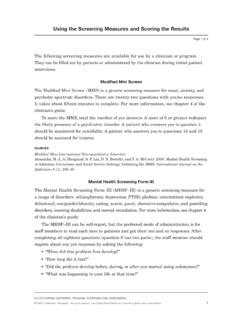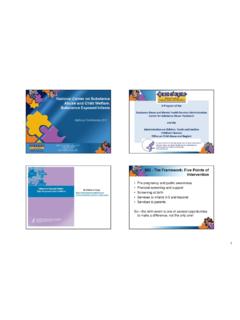Transcription of What Is Post-traumatic Stress Disorder?
1 FACT SHEET 8.. Post-traumatic Stress Disorder What Is Post-traumatic Stress Disorder? Research indicates that 7 to 12 percent of people develop Post-traumatic Stress disorder (PTSD) at some point in their lives, with women more likely than men to develop it. PTSD is an anxiety disorder that can occur after a person experiences a traumatic event such as combat or military experience, sexual or physical abuse or assault, a serious accident, or a natural disaster such as a fire, tornado, flood, or earthquake. Some people develop PTSD after seeing someone else experience a traumatic event. The more severe and the greater the number of traumatic events experienced, the more likely someone is to develop the disorder.
2 PTSD often leaves one feeling vulnerable, out of control, and as if one is in constant danger. These feelings are persistent, are strong, and do not disappear over time on their own. Everyday life, work, and relationships can be negatively affected. What PTSD Is Not Most people experience a traumatic event at some point in their lives, and they often have negative feelings and agitation immediately afterward. This response is normal, and often the negative feelings go away over the following several weeks. Such a response is not PTSD. To be diagnosed with PTSD, the person must have persistent trauma-related problems for at least a month after the event. The person must also have specific symptoms, which are described below.
3 What Are the Symptoms of PTSD? PTSD is defined as experiencing three types of persistent symptoms following a traumatic event: re-experiencing the event through intrusive memories, dreams, or flashbacks, or feeling distress upon exposure to trauma-related stimuli avoidance of people, places, or things that remind the person of the traumatic event; numbing of feelings or detachment from others increased arousal, including increased heart rate and muscular tension, restless- ness, difficulty sleeping, irritability, poor concentration, feeling on guard or hyper- vigilant, or having an exaggerated startle response Page 1 of 4. CO-OCCURRING disorders PROGRAM: FAMILY PROGRAM. 2008 by Hazelden Foundation.
4 All rights reserved. Duplicating this material for personal or group use is permissible. 41. Post-traumatic Stress Disorder Page 2 of 4. What Is the Cause of PTSD? PTSD is caused by exposure to a traumatic event such as physical or sexual abuse, violence, combat, natural disaster, or accident. It is unknown why some people develop PTSD in response to traumatic events, while others do not. The risk of developing PTSD. after exposure to a trauma appears to be related to a combination of genetic predisposition and environmental factors. People with other psychiatric disorders are more likely to develop PTSD after a traumatic event. What Are the Usual Treatments for PTSD? Medication and therapy are the two most effective treatments for PTSD.
5 Antidepressants are an effective treatment. Although antidepressants can reduce PTSD symptoms and improve functioning, once the medications are discontinued, the symptoms often return.*. Therapy methods that have proven to be effective include exposure therapy and cognitive-behavioral therapy (CBT). To reduce anxiety and PTSD symptoms, exposure therapy focuses on re-confronting, in a safe way, memories, situations, places, people, or events related to the trauma. CBT works by teaching people how to identify, challenge, and change negative trauma-related thoughts with more accurate and adaptive ones. CBT often also includes teaching anxiety management techniques such as relaxation, positive thinking, and thought stopping.
6 Therapy based on these methods can both reduce the frequency and severity of symptoms, and sometimes eliminate the disorder. In contrast to medication, gains made with either exposure therapy or CBT last long after the therapy is over. How Does the Use of Alcohol and Other Drugs Affect PTSD? People with PTSD often seek relief with alcohol or drugs. Re-experiencing trauma in nightmares and flashbacks is upsetting, and sometimes a person may try to reduce or escape those feelings by using alcohol or drugs such as cocaine, heroin, or marijuana. Similarly, people often use substances to cope with their anxiety or as a numbing anesthetic to ease their pain. Finally, in an attempt to live a normal life in the company of others, a person may use substances in order to facilitate sexual relationships, socialize with friends, or even work more easily with others.
7 Although this kind of substance-use solution is counterproductive in the long run, it often reflects the user's wish to simply * More information on antidepressants can be found in Handout 1, Antidepressant Medications. CO-OCCURRING disorders PROGRAM: FAMILY PROGRAM. 42 2008 by Hazelden Foundation. All rights reserved. Duplicating this material for personal or group use is permissible. Page 3 of 4 Post-traumatic Stress Disorder get through life as normally as possible, using the substance as an aid. People with PTSD who have substance use disorders often have worse PTSD symptoms over time and develop more severe addiction problems. How Does PTSD Affect Addiction Treatment and Recovery? Even if a person with PTSD stops using drugs or alcohol, the Post-traumatic Stress dis- order is still present.
8 In fact, many people find that once they are no longer under the influence of substances, their PTSD symptoms return or get worse with a vengeance. This is why it is particularly important for addiction treatment providers to screen and assess for PTSD, so that as substance use disorders are being addressed, treatment can also begin for PTSD. People with PTSD who do not receive treatment have a more challenging recovery from addiction and are at greater risk for relapse. Because of the symptoms of PTSD such as social avoidance, having troubling flashbacks, and irritability patients may also have more trouble connecting in peer support groups such as AA (Alcoholics Anonymous) or NA (Narcotics Anonymous).
9 Treatment for Co-occurring PTSD. and a Substance Use Disorder Unfortunately, there is no evidence to suggest that treatment for PTSD will also fix a substance use disorder. And, as mentioned above, many people beginning to abstain from substances actually experience a worsening of PTSD symptoms. Therefore, the best option is integrated or combined treatment for both substance use and PTSD. Addiction treat- ments should focus on the substance use. To address the PTSD, therapy, medications, or both can be used. With these, the person can develop coping skills that will help manage or overcome the symptoms far more effectively than drugs or alcohol ever could. People with PTSD can benefit from attending peer support groups, and can also benefit from connecting with others who have these co-occurring disorders and are in recovery.
10 Resources Copeland, M. E., and M. Harris. 2000. Healing the trauma of abuse: A woman's workbook. Oakland, CA: New Harbinger. Matsakis, A. 1996. I can't get over it: A handbook for trauma survivors. 2nd ed. Oakland, CA: New Harbinger. Post-traumatic Stress disorder (PTSD). Available at CO-OCCURRING disorders PROGRAM: FAMILY PROGRAM. 2008 by Hazelden Foundation. All rights reserved. Duplicating this material for personal or group use is permissible. 43. Post-traumatic Stress Disorder Page 4 of 4. Naparstek, B. 2005. Invisible heroes: Survivors of trauma and how they heal. New York: Bantam. National Institute of Mental Health. Post-traumatic Stress disorder (PTSD). Available at National Institute on Alcohol Abuse and Alcoholism.















